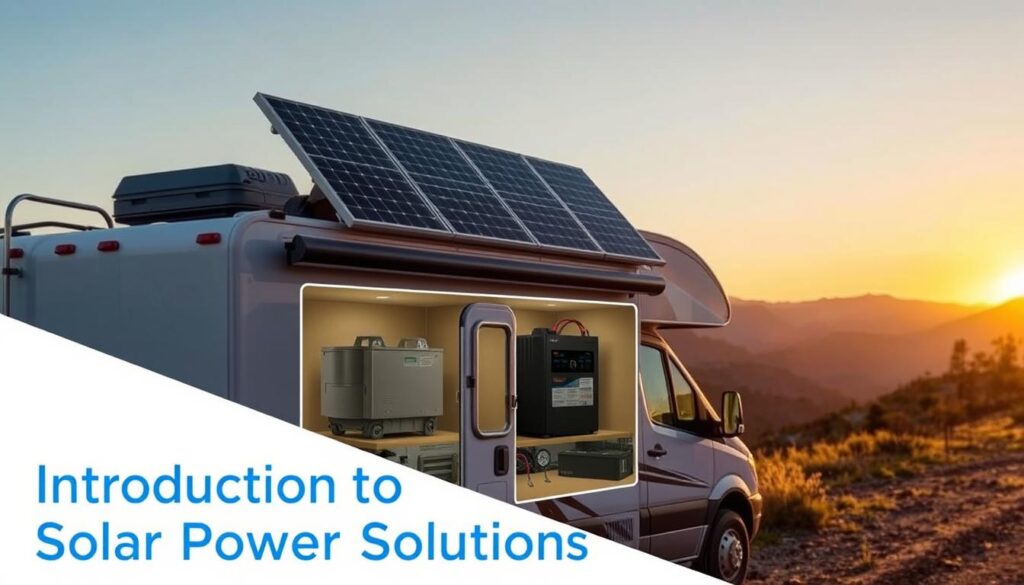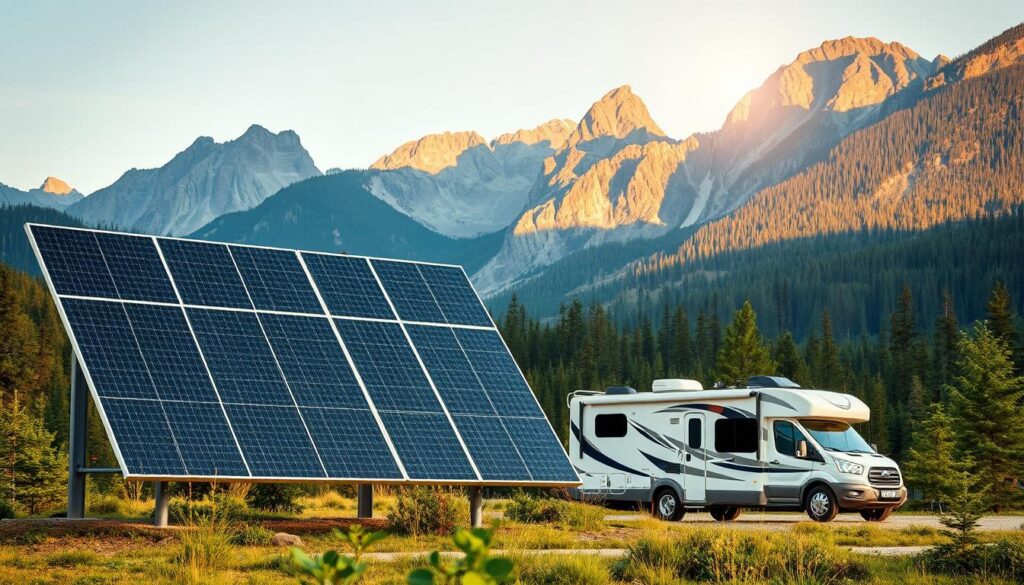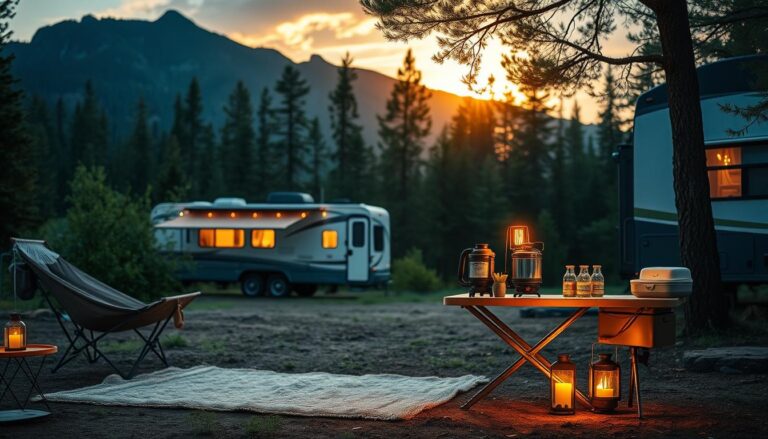Harness the Sun: Solar Panels for RV Camping
Solar panels for RV camping are changing how we travel. More people are choosing RV solar power systems for eco-friendly adventures. These systems give clean energy, cutting down on generator use or campsite power.
Brands like REDARC and OUPES are at the forefront. They make panels tough for the outdoors. Their products are both efficient and durable, working well in remote spots. Solar tech lets us charge devices, run appliances, and enjoy comforts while staying green.
Going solar is more than just a convenience – it’s a smart choice. RV solar power systems save money on electricity and help the planet. As solar energy becomes more popular, it’s becoming a key part of flexible, independent travel.
Key Takeaways
- Solar panels for RV camping enable energy independence and cost savings.
- Top brands like REDARC and OUPES offer durable, efficient solutions.
- RV solar power systems reduce reliance on traditional energy sources.
- Modern panels fit seamlessly into camping setups without sacrificing performance.
- Investing in solar improves sustainability and extends travel flexibility.
Introduction to RV Solar Power Solutions
RV solar power solutions are a great way to power your travels. They use sunlight to make electricity and store it in batteries. This means you can use your appliances and electronics without needing campgrounds or generators.

Why Go Solar on the Road?
Modern RV solar power solutions make life on the road easier. They give you power in places where electricity is not available. Plus, they need little upkeep and are quiet, perfect for long trips.
Benefits of Solar Energy for RVs
- Cost savings: Use less expensive solar power instead of generators and campsite hookups.
- Environmental impact: Solar power is better for the planet than fossil fuels.
- Freedom: Get power anywhere, from deserts to mountains.
“Over 40% of people that camp now invest in solar systems to enhance their camping experiences.”
More people are choosing RV solar power solutions as technology gets better and cheaper. Today’s systems are lighter, stronger, and simple to set up. They fit well into the modern RV lifestyle.
Top Solar Panel Options for RV Camping
Choosing the right solar panels for RV camping depends on your energy needs and preferences. Popular options are known for their power, durability, and ease of use. Here’s a look at the top choices based on real reviews and performance.

Best Solar Panels for RV Camping
Leading brands offer reliable solutions. Here’s a comparison of the best:
| Brand | Product | Wattage | Efficiency Rating |
|---|---|---|---|
| Renogy | 100W Monocrystalline Solar Panel | 100W | 19.5% |
| Goal Zero | Lithium 100W Solar Panel | 100W | 20.3% |
| Wagan | 100W Foldable Solar Panel | 100W | 18.2% |
Key Features to Consider
When picking panels, look for these features:
- Efficiency: Higher wattage per square foot means more energy in less space.
- Durability: UV-resistant coatings and rugged frames withstand outdoor conditions.
- Portability: Foldable designs simplify setup and storage.
- Compatibility: Check voltage and connector types for your RV system.
Comprehensive Guide to RV Solar Panel Kits
RV solar panel kits make setting up energy easy. They come with everything you need. This includes solar panels, charge controllers, inverters, and mounting hardware. All these parts work together to power your RV well.
- Solar panels for energy collection
- Charge controllers to regulate battery charging
- Inverters converting DC to AC power
- Mounting brackets for secure installation
| Component | Purpose |
|---|---|
| Solar Panels | Convert sunlight into electricity |
| Charge Controller | Prevents battery overcharging |
| Inverter | Delivers usable power to appliances |
Choosing the right RV solar panel kit is important. Make sure it matches your RV’s power needs. Check if it fits with your current system, like OUPES power stations. For example, a 300W kit works well with a 12V system.
Also, think about how portable the kit is. Look for lightweight panels and strong connectors.
Here are some installation tips:
Place panels where they get the most sunlight. Make sure cables are secure to avoid damage. Test everything before you start using it. Doing this right helps your equipment last longer and work better.
Evaluating Solar Panel Efficiency for RV Use
Choosing the right solar panels for your RV is key. It’s all about how well they meet your energy needs. The amount of power you get depends on sunlight and where you place the panels.
Understanding Efficiency Metrics
Efficiency metrics show how well panels turn sunlight into energy. Look for panels with high wattage for their size. Also, check the temperature coefficient—lower is better in hot weather. Third-party certifications like IEC 61215 prove they’re durable and efficient.
- Wattage Output: More watts per square foot means more energy.
- Temperature Coefficients: Panels with coefficients under -0.3% per °C work well in heat.
- Light Exposure: Position panels for the best sunlight, like on angled roofs.
Maximizing Solar Performance
Make your setup work better with a few tweaks. Adjust panel angles with the seasons and clean them often. Use MPPT charge controllers to get the most power. Smart apps help track performance for better efficiency.
“Proper alignment can increase energy gains by up to 20% in sunny regions.” — Solar Energy Industries Association
Match efficient panels with good battery storage. Avoiding shade and keeping panels clean helps in partial sunlight. Follow these tips to maximize your solar investment.
Portable Solar Panels for RV: Flexibility on the Go
Portable solar panels for RVs give travelers unmatched freedom. These systems are made to move with you. They provide power without taking up too much space or weight.
They are designed for adventure. They fold, roll, or clip into place. This makes them perfect for any journey.
Lightweight and Durable Designs
- Compact materials: Aluminum frames and flexible polymers resist rough terrain.
- Easy storage: Foldable models pack into RV compartments or rooftop racks.
- Weather resistance: UV-protected surfaces handle rain, dust, and extreme temperatures.
Installation and Setup Tips
Follow these steps to maximize energy harvest:
- Position panels where sunlight hits strongest—like open fields or parking spots.
- Secure panels with magnetic mounts or straps to avoid movement during travel.
- Use adjustable stands to tilt panels toward the sun’s path for peak efficiency.
Portable solar panels for RVs make setups easy. They let users recharge batteries or power appliances anywhere. Pair them with smart charge controllers for safer energy management.
Affordable RV Solar Panels: Balancing Cost and Quality
Affordable RV solar panels are a great choice for budget-conscious campers. The initial cost may seem high, but the long-term savings and incentives make it worth it. Begin by looking into federal and state programs that can help lower your expenses.
- Claim tax credits: The federal Investment Tax Credit covers 26% of system costs.
- Buy refurbished: Certified pre-owned panels save 30–50% of new prices.
- Compare brands: Quality and price differ widely across models.
“My $300 system paid for itself in 18 months through saved generator fuel.” – Laura M., Full-Time RVer
| Brand | Price Range | Key Features |
|---|---|---|
| Renogy | $200–$500 | 25-year warranty, 22% efficiency |
| Goal Zero | $300–$600 | Expandable kits, app monitoring |
| Wagan | $150–$300 | Compact, weather-resistant |
Look into state programs like California’s Self-Generation Incentive Program (SGIP) for extra rebates. High-efficiency panels like Renogy’s 100W model cost $200 but last over 25 years. Choose brands with good warranties and energy ratings to avoid cheap, low-quality panels. Making smart choices today leads to clean energy and financial benefits tomorrow.
Durability and Reliability: RV Solar Power System Insights
Off-grid RV solar panels face tough travel and weather. They need to be built strong to last. Brands like Renogy and Goal Zero are known for their durability in harsh conditions.
Long-Term Benefits
Strong designs mean less need for replacements, saving money. Many systems come with 25-year warranties. Users say these systems need fewer repairs than older ones.
Comparative Brand Reviews
- Renogy: Offers modular kits that handle extreme temperatures. Customers love how fast they charge in deserts and snowy places.
- Goal Zero: Has compact panels perfect for small RVs. Their Yeti series batteries work great with solar setups for off-grid living.
- Victron Energy: Uses advanced MPPT charge controllers for better energy flow. Tests show they perform well in humidity and dust.
“Our Victron system never failed even during a month-long desert trip. The panels stayed intact despite sandstorms.” – RV user review
Tests show systems with tempered glass last longer than cheaper ones. Choose brands that show real-world performance, not just marketing.
Understanding Off-Grid RV Solar Panel Installations
Going off-grid with solar panel installation for rv needs careful planning. First, figure out how much energy you use each day. This helps decide how big your panels and batteries should be.
“A well-designed off-grid system balances energy generation, storage, and usage.” — Solar Energy Industries Association
Here are the main steps:
- Mounting: Pick roof or awning mounts like Renogy’s aluminum racks for stability. Make sure panels face south for the most sun.
- Wiring: Use UV-resistant cables and MC4 connectors to link panels to a charge controller. Run wires through roof hatches safely to avoid damage.
- Battery Setup: Pair panels with deep-cycle batteries (e.g., BattleBorn Lithium) to store extra energy. Keep batteries in a well-ventilated spot to avoid overheating.
- Inverter Selection: Choose a pure sine wave inverter from brands like Victron. It turns solar power into electricity your devices can use.
Remember safety: Use circuit breakers and fuses that match your system’s voltage. Grounding systems must meet NEC standards to avoid electrical dangers. Regular checks keep your system running well.
Get a pro to install it right. Certified technicians ensure your setup meets off-grid standards. For DIY, check out the Solar Living Sourcebook for detailed guides. Focus on quality parts and correct setup for the best solar panel installation for rv results.
Essential Tips for Maintaining Your RV Solar Setup
Regular cleaning and checks on your best solar panels for RV keep them working well. Simple steps help avoid breakdowns and keep energy production up.
Regular Maintenance Routines
Here’s how to keep your system in top shape:
- Wipe panel surfaces weekly with a soft cloth to remove dust or bird droppings.
- Check electrical connections monthly using a multimeter to test voltage and current flow.
- Inspect mounting brackets twice a year to avoid loosening from road vibrations.
Troubleshooting Common Issues
Fix these problems fast to prevent damage:
- Low energy output: Shade or debris blocking panels reduces efficiency. Clear obstructions immediately.
- Battery drain: Check wiring for corrosion at terminals. Replace corroded parts promptly.
- No power generation: Ensure inverters are plugged in and solar controllers are set to “auto mode.”
Check your system’s manual for specific tips. For complex repairs, call certified technicians. Regular care extends your best solar panels for RV life, saving money in the long run.
Conclusion
Solar energy for RVs changes how we travel. It cuts down on utility costs and lets us go off-grid. Brands like Renogy and Goal Zero offer efficient and durable systems.
This guide covered important topics: choosing the right panels, installing them, and keeping them running well. These steps are key to getting the most out of your solar setup.
Using solar energy means being flexible and green. It works well in deserts or forests, giving us energy freedom. Choosing quality brands and taking good care of your system makes it last longer.
As more people want eco-friendly travel, solar is a great choice. It’s perfect for RV lovers who want to explore freely and sustainably.






